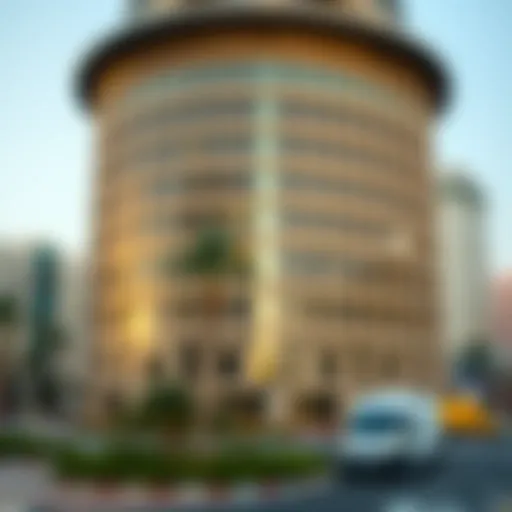Exploring Iconic Architectural Structures of the UAE
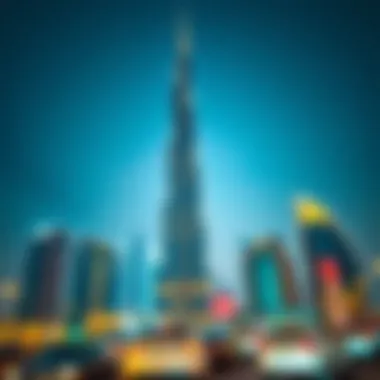
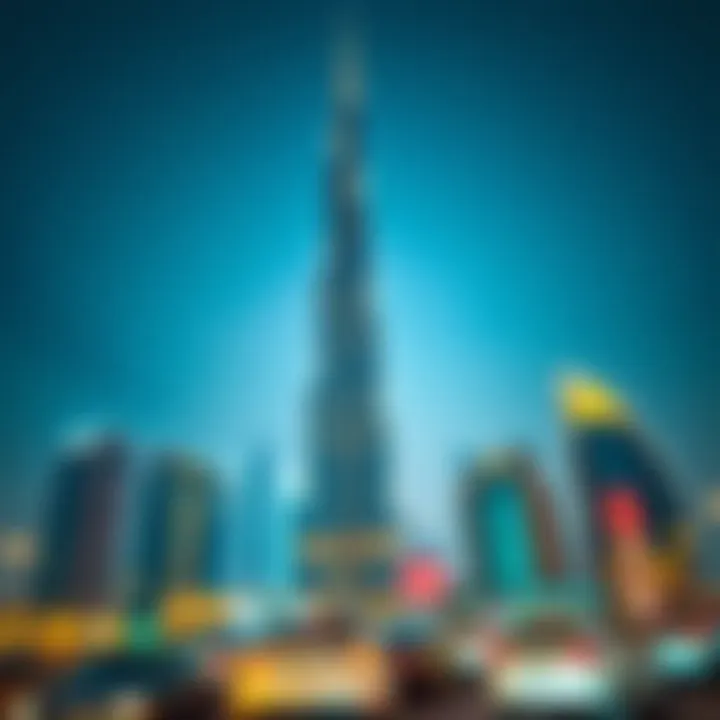
Intro
The United Arab Emirates (UAE) stands as a remarkable juxtaposition of ancient heritage and modern ambition, with its architectural wonders showcasing this duality brilliantly. From the towering heights of the Burj Khalifa to the intricate embellishments of the Sheikh Zayed Grand Mosque, every structure tells a story that goes beyond just bricks and mortar. This article delves deep into the notable architectural landmarks across the UAE, highlighting their aesthetic allure, cultural significance, and the roles they play in shaping the identity of a nation that has rapidly transformed over the past few decades.
In understanding these landmarks, it is not just about the designs or engineering marvels; it is about their connection to the people, traditions, and aspirations of the Emirati nation. As we navigate this architectural journey, we will uncover how these edifices symbolize the rich history and ambitions of a country stepping firmly onto the global stage.
Many of these structures have become icons, not just for the UAE, but for the world; locations where business meets leisure, where tradition intertwines with innovation. Therefore, it’s vital for investors, agents, homebuyers, and managers to appreciate these key highlights, as they can influence their decisions regarding investments and engagement within the region.
In the following sections, we will provide a comprehensive overview of the current market trends, the future potential of investments, and the opportunities that exist within residential and commercial properties, all while keeping our focus on the architectural gems that stand as beacons of the UAE's success.
Prologue to Architectural Significance
In the United Arab Emirates, architecture serves as a vibrant testament to the nation's cultural identity and historical evolution. The significance of architectural landmarks extends far beyond their aesthetic appeal; they showcase the ingenuity, creativity, and vision that characterize the UAE's rapid transformation into a global hub. Each building, from skyscrapers piercing the clouds to serene mosques embodying spirituality, tells a story entwined with tradition and modernity.
Understanding architectural significance involves not only appreciating the structures themselves but also recognizing their role in shaping the urban landscape. These landmarks are not just constructions of bricks and mortar, but rather, they act as cultural symbols that reflect societal values, aspirations, and historical narratives.
Key Elements of Architectural Significance
- Cultural Reflection: Each landmark often mirrors the cultural context of its time, showcasing influences from Islamic traditions, Bedouin heritage, and contemporary innovative practices.
- Historical Narrative: Many structures have rich histories, marking milestones in the nation’s journey. For instance, the Sheikh Zayed Grand Mosque serves as a reminder of the late Founding Father’s vision for unity and peace.
- Innovative Design: Today’s architects fuse traditional elements with cutting-edge technology, resulting in unique designs that push the boundaries of what is possible in construction.
- Sustainability Practices: As global concerns about the environment rise, many UAE buildings incorporate eco-friendly materials and energy-efficient systems, setting an example for future developments.
Benefits of Appreciating Architectural Significance
- Economic Opportunities: Investors and homebuyers gain insight into areas of growth and development, enabling informed decisions in a rapidly changing market.
- Cultural Appreciation: Understanding the architectural landscape fosters respect for the diverse cultures that converge within the UAE, enriching the collective identity.
- International Recognition: Unique designs contribute to the UAE's standing globally, attracting tourists and influencing architectural trends elsewhere.
"Architecture can be both a mirror and a window: it reflects the culture of a community while revealing its aspirations for the future."
Cultural Context of UAE Architecture
When discussing the architectural landscape of the United Arab Emirates, one cannot overlook the cultural context that plays a significant role in shaping its structures. The UAE's rapid development has created a unique blend of tradition and modernity. This fusion isn’t merely coincidental; it emerges from the rich tapestry of its history, society, and the diverse influences that have traversed this region over the centuries.
The geographical position of the UAE, nestled between the East and West, has historically made it a trading hub. Merchants, travelers, and scholars have all left their marks. As a result, UAE architecture exhibits a cornucopia of styles that reflect the influences of Persian, Indian, and Islamic architecture, mingled seamlessly with modern design principles.
Influences on Architectural Styles
- Islamic Heritage: Islamic architecture has deeply influenced the local building practices. The use of geometric patterns, ornate calligraphy, and the grandeur of mosques are evident in structures like the Sheikh Zayed Grand Mosque.
- Bedouin Traditions: There's a potent influence from the nomadic culture of the Bedouins. Often, traditional designs incorporated local materials and were adaptive to the desert climate, as seen in Al Ain’s forts and palaces, which utilized mud and stone.
- Globalization: In recent decades, globalization has introduced international architecture's clean lines and innovative designs. The Burj Khalifa exemplifies how international styles have melded with local culture. This skyscraper doesn't just push the boundaries of engineering; it tells a story of ambition reflective of the nation's vision.
Benefits to Society
- Cultural Preservation: By maintaining aspects of traditional architecture, the UAE fosters a sense of identity and pride among its residents.
- Tourism Growth: The rich architectural diversity attracts visitors worldwide, contributing significantly to the economy.
- Community Building: Contemporary architectural projects, like the Dubai Mall, are developed into community hubs, allowing for social interaction and public engagement.
Considerations for Future Development
As the UAE continues to evolve, it faces challenges associated with maintaining its cultural identity amid rapid modernization. Architects and developers must consider:
- How to balance innovation with preservation.
- The need for sustainable practices that reflect both cultural values and environmental considerations.
- Ensuring that new designs resonate with the local populace rather than merely serve tourist interests.
“Architecture is the testament of a nation’s history, capturing its values, aspirations, and the spirit of its people.”
Understanding this context is essential for investors, agents, homebuyers, and managers who navigate this ever-evolving landscape. The interplay of tradition and progress will undoubtedly influence future investments and urban developments in the UAE.
Burj Khalifa: The Iconic Skyscraper
The Burj Khalifa stands not merely as a building but as a testament to human ingenuity and ambition. Towering at a staggering 828 meters, it holds the title of the tallest structure in the world. Situated in Dubai, the Burj Khalifa defines not just the skyline of this vibrant city but also symbolizes the rapid growth and modernization of the United Arab Emirates. As we delve deeper, it’s essential to appreciate how this architectural marvel influences the cultural and economic landscape, providing a rich tapestry of significance.
Design and Construction
The design of the Burj Khalifa was conceived by the renowned architectural firm Skidmore, Owings & Merrill, led by Adrian Smith. The structure features a unique Y-shaped footprint, maximizing views of the surrounding landscape while minimizing wind load on the building. The use of reinforced concrete and sleek glass gives it a striking look, making it stand out prominently against the azure sky and the desert backdrop.
**"The Burj Khalifa is more than just an architectural feat; it's a beacon of hope and ambition for the UAE's future."
Constructed meticulously over just six years, the project involved over 12,000 workers at peak times. The serious attention given to detail brings about an astounding blend of sustainability and luxury. Innovative technologies were implemented to ensure energy efficiency, including a condensation collection system adopted for water conservation. Key features such as the observation decks allow visitors to enjoy panoramic views, while high-speed elevators whisk them up to dizzying heights in mere seconds.
Cultural Impact
The cultural impact of the Burj Khalifa is multifaceted. Beyond its architectural significance, it has become a global icon—drawing tourists from across the globe eager to experience its grandeur. Each New Year's Eve, the building plays host to a spectacular firework show, further endearing it to both residents and visitors alike.
Moreover, it fosters a sense of national pride among Emiratis. The Burj Khalifa serves as a venue for various cultural events, including the Dubai International Film Festival and numerous art exhibitions, which reflect the UAE's dedication to fostering a rich cultural landscape.
The influence of the Burj Khalifa extends into the realms of business and investment, attracting multinational corporations eager to set up their headquarters in such a prestigious location. Its presence reaffirms Dubai’s status as a leading global city and an attractive destination for investments.
The Burj Khalifa isn't just a structure; it represents a bold narrative of what the UAE has accomplished and aims to achieve, serving as an emblem of progress in the architectural realm.
The Sheikh Zayed Grand Mosque: A Spiritual Epicenter
The Sheikh Zayed Grand Mosque isn't just a place of worship. It's a beacon of architectural magnificence and cultural expression in the heart of Abu Dhabi. This mosque stands as a testament to the vision of Sheikh Zayed bin Sultan Al Nahyan, the founder of the UAE, who believed in bridging cultures and promoting peace through spirituality and simplicity.
Constructed between 1996 and 2007, the mosque embodies a blend of various architectural styles, drawing on influences from Persian, Mughal, and Moorish designs. It's not merely the size or beauty that makes it significant; it's the entire atmosphere surrounding this sacred space.
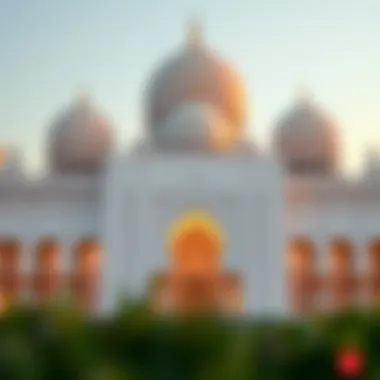
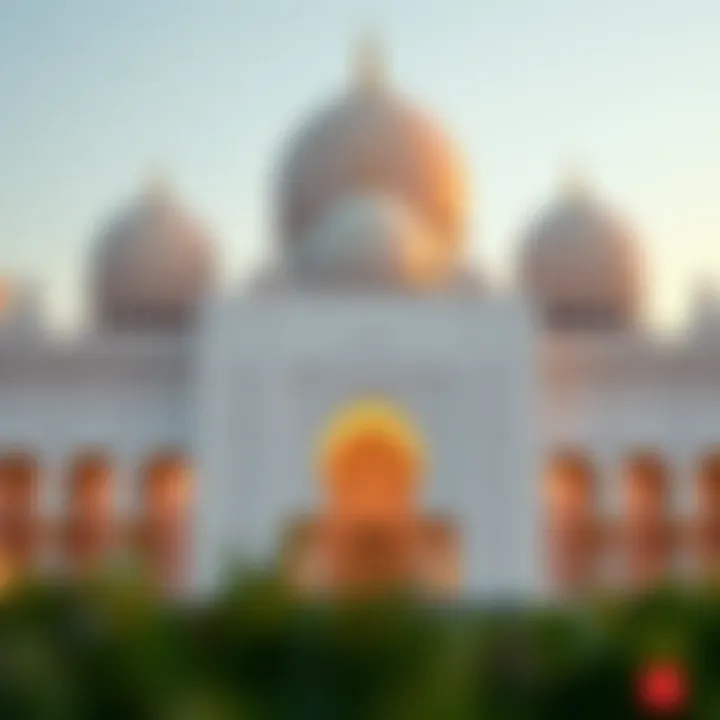
The mosque welcomes millions of visitors, both Muslims and non-Muslims, resulting in a rich tapestry of cultural exchange. It demonstrates how architecture can transcend mere function, evolving into a medium that fosters understanding and unity among diverse populations.
Architectural Features
The architectural features of the Sheikh Zayed Grand Mosque are nothing short of breathtaking. Covering 30 acres, it holds the title for one of the largest mosques in the world. Those entering the mosque are immediately struck by the grand scale and exquisite details. Here are a few standout features:
- Domes and Arches: The mosque boasts 82 domes of varying sizes, each decorated with intricate patterns that reflect the artistry of Islamic design. The main dome, sitting 85 meters high, is the largest of its kind in the world.
- Minarets: Four minarets rise to a height of 107 meters, each embodying the classic design of Muslim structures with elegant finishes that invite visitors to look upward and appreciate.
- Materials Used: Constructed from pure white marble, the exterior is adorned with rare stones and precious materials. The interior features a stunning carpet, one of the largest in the world, handmade and representing the richness of local craftsmanship.
- Water Features: Surrounding the mosque is a pristine reflecting pool that mirrors its grand architecture, creating a serene environment conducive to contemplation and spiritual reflection.
These architectural marvels don’t just serve aesthetic purposes; they create an overall environment of tranquility and reverence that enhances the spiritual experience of those who visit.
Cultural Significance
The significance of the Sheikh Zayed Grand Mosque extends far beyond its architectural brilliance; it plays a pivotal role in the cultural fabric of the UAE and the broader Islamic community. Here’s why:
- Cultural Education: The mosque serves as an educational platform, offering tours and sessions that help people learn about Islamic traditions, art, and history. It bytes sized down the barriers that often exist in understanding this rich culture.
- Interfaith Dialogue: Acting as a bridge between different faiths, it emphasizes tolerance and respect. Sheikh Zayed believed in the importance of dialogue among nations and cultures. The mosque embodies this principle by welcoming individuals from various backgrounds.
- Symbolism of Unity: The mosque signifies Abu Dhabi’s commitment to promoting peace and understanding. Its design and mission reflect the principles of inclusion and collaboration, standing as a powerful reminder of the importance of community.
- Celebratory Venues: Through various events, such as Ramadan prayers, cultural festivals, and exhibitions that showcase Islamic arts, the mosque becomes a hub for cultural interaction, further enhancing its significance in society.
Overall, the Sheikh Zayed Grand Mosque is more than just a place of worship; it's an architectural wonder and a cultural beacon aimed at fostering connections. It encapsulates a profound narrative of unity, showcasing how such structures can resonate far beyond their physical attributes.
"The true essence of the mosque is seen not just in its grandeur, but in its ability to connect hearts and minds through shared experiences."
For more information about this architectural marvel, visit Sheikh Zayed Grand Mosque.
The Louvre Abu Dhabi: A Blend of Cultures
The Louvre Abu Dhabi isn’t just an architectural masterpiece; it represents a crossroads of cultures. This museum stands as a testament to the UAE's commitment to promoting cultural exchange and understanding. Its unique approach to art transcends national boundaries, making it a significant pillar in the architectural and cultural landscape of the nation. Through its design and curated artworks, the Louvre Abu Dhabi encapsulates the essence of collaboration between the East and the West, offering valuable insights into how contemporary museums can foster global dialogue.
Architectural Design
At first glance, what strikes visitors the most is the stunning architectural design of the Louvre Abu Dhabi. The museum, designed by the Pritzker Prize-winning architect Jean Nouvel, boasts a striking dome that is both functional and symbolic.
- Dome Design: The dome is a marvel, comprising a complex pattern of interlocking stars that creates a stunning 'rain of light' effect beneath it. Sunlight filters through, providing a mesmerizing experience that mimics the traditional Arabic mashrabiya screens.
- Cultural Symbolism: Extending beyond aesthetics, this design symbolizes a connection between diverse cultures and civilizations. As visitors move through the museum, they experience a seamless flow of art and architecture that encourages reflection on shared human experiences.
- Sustainability Features: Moreover, the building is designed with sustainability in mind. It integrates energy-efficient systems and reflects the region’s climate adaptability, further enhancing its architectural significance.
Artistic Contributions
The Louvre Abu Dhabi is not just about its architectural splendor; it's also a treasure trove of artistic contributions that enrich its narrative. The museum houses over 600 artworks and artifacts, representing a mélange of traditions and histories from various cultures.
- Diverse Collections: From ancient civilizations to contemporary art, the collections span centuries. The museum showcases pieces from renowned masters like Leonardo da Vinci and Vincent van Gogh, alongside artifacts that tell the stories of the Islamic world and other cultures.
- Collaborative Initiatives: Additionally, the Louvre Abu Dhabi highlights the importance of collaborative initiatives. The museum's partnership with the Louvre in Paris has facilitated the exchange of artwork and knowledge, offering visitors a unique perspective on global art.
- Cultural Programs: Furthermore, the museum is committed to hosting cultural programs that promote dialogue and understanding. These offerings include art workshops, lectures, and performances, transforming the museum into a vibrant hub for cultural expression and education.
The Louvre Abu Dhabi embodies not just the art and architecture of the UAE but stands as a beacon of cultural dialogue, connecting people through the universal language of creativity.
In sum, the Louvre Abu Dhabi is an extraordinary blend of architectural ingenuity and artistic wealth. Its design and the richness of its collections echo the UAE's role in the global cultural arena, offering valuable insights into the power of art and architecture to foster understanding across diverse cultures.
Dubai Mall: More than Just a Shopping Destination
The Dubai Mall stands out not merely as a retail hub but as a monumental feat of architecture and urban planning. It embodies a combination of cultural, social, and economic dimensions that position it squarely as a critical landmark in UAE’s architectural narrative. Its influence extends beyond shopping and leisure, manifesting in how it reshapes perceptions of consumer culture in the Emirates while drawing in millions of tourists every year.
Innovative Design and Facilities
The architectural design of Dubai Mall showcases an extraordinary blend of modern aesthetics and functionality. Spanning over 1.1 million square meters, it's known as one of the largest malls in the world. Its ultra-modern style incorporates graceful lines and responsive layouts, and it operates under the auspices of the renowned Emaar Properties. The facade features dynamic glass panels, creating an enchanting ambience during both day and night.
- The Burj Khalifa View: The mall’s proximity to the Burj Khalifa offers breathtaking views of the iconic structure, especially during the evening fountain shows, making it a visual delight.
- Attractions: Apart from shopping, it hosts a plethora of attractions including an indoor ice rink, the Dubai Aquarium & Underwater Zoo, and VR Park, ensuring visitors have a multi-faceted experience.
- Sustainability Efforts: The design also emphasizes sustainable practices, as seen in its efficient water management and energy-saving initiatives, which align with the UAE’s vision for environmental responsibility.
These features encapsulate what makes the Dubai Mall not just a space for commerce but a realm of experiences that enrich the lifestyle of its visitors and residents alike.
Economic Impact
The economic influence of Dubai Mall is monumental, contributing significantly to both local and national economies.
"Dubai Mall is more than a retail space; it fuels the economic engine of Dubai, enabling diverse sectors to thrive."
- Tourism Growth: The mall attracts over 80 million visitors annually, acting as a magnet that draws tourists from around the globe. This influx results in increased spending on hospitality, transportation, and other local businesses, boosting the overall tourist economy.
- Job Creation: With thousands of shops and entertainment venues, the Dubai Mall creates numerous employment opportunities, making it a vital player in the city’s job market. From retail staff to management roles, the mall supports a wide array of careers.
- Commercial Hub: By hosting flagship stores for numerous global brands, Dubai Mall positions itself as a premiere destination for international retail, thus enhancing Dubai's reputation as a commercial business center on par with New York and London.
In summary, the Dubai Mall embodies the UAE's architectural spirit and underscores its economic dynamism, making it much more than a simple shopping destination.
The Emirates Palace: Luxury Redefined
The Emirates Palace stands as a true emblem of opulence and extravagance in the United Arab Emirates. Serving not only as a luxury hotel but also as a symbol of the nation’s hospitality and ambition, it reflects the cultural richness and historical depth of the UAE. The significance of the Emirates Palace extends beyond its dazzling façade; it embodies a perfect blend of traditional Arabian design and modern luxury, making it a focal point in discussions about architectural landmarks in the region.
Most strikingly, this grand structure attracts attention not just from tourists but also from investors and architects who find inspiration in its intricate details and impressive scale. The elegance of its design, combined with its role as a venue for international events and summits, solidifies its importance in elevating the UAE's profile on the global stage.
Architectural Opulence
The architectural features of the Emirates Palace are nothing short of breathtaking. Spanning over 1.3 kilometers of private beach, the structure exhibits an exquisite blend of Arabesque design, contemporary aesthetics, and state-of-the-art engineering.
- Design Elements: With 114 domes and over 1,000 columns, the design showcases intricate patterns inspired by Islamic art. The lobby, with its stunning golden atrium, features a grand chandelier weighing more than two tons, a sight that simply leaves onlookers in awe.
- Materials Used: The building is laced with luxurious materials including Italian marble, handcrafted carpets, and crystal chandeliers. Walls adorned with gold leaf accents and rich textiles amplify its regal appearance, serving as a tactile experience that is unique and lavish.
"The Emirates Palace isn’t just an architectural marvel; it is a cultural statement of how the past and future can coexist harmoniously."
The sheer size of the palace allows it to house over 400 rooms and suites, each designed to offer the utmost comfort while adhering to the core theme of luxury. Such attention to detail not only highlights the cultural significance but also emphasizes the sophisticated architectural narrative of the UAE.
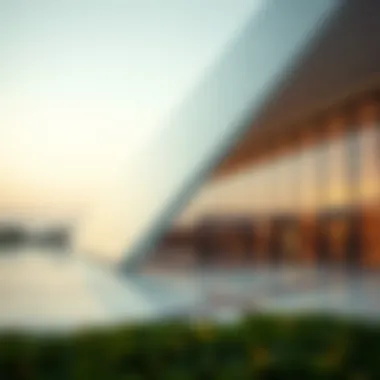
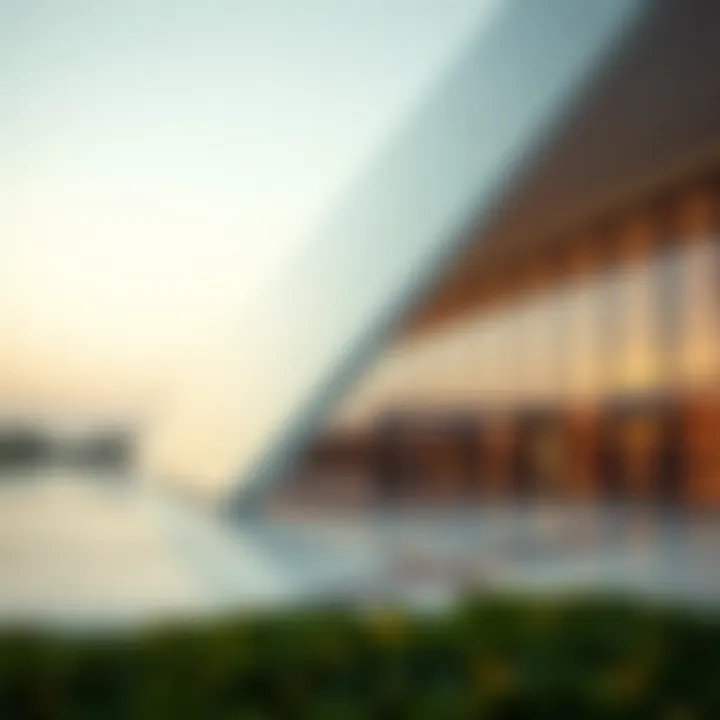
Culinary Excellence
Beyond its architectural grandeur, the Emirates Palace is also known for its culinary excellence. The palace boasts 14 prestigious dining options, each offering a distinct culinary experience that caters to global palates.
- Local and International Cuisine: The hotel’s offerings range from traditional Emirati dishes to gourmet international cuisine, allowing visitors to enjoy a gastronomic journey through various cultures. Signature restaurants like Mezzaluna, famous for its Italian delicacies, and Al Iwan, known for its lavish buffet, showcase the restaurant’s commitment to quality and authenticity.
- Unique Experiences: One standout feature is the Gold Cappuccino, where creamy, frothy coffee is topped with real gold dust, epitomizing the luxurious dining experience that the Emirates Palace strives to provide. This extravagant touch makes it a must-try for visitors, symbolizing the palace’s dedication to exquisite service and luxurious experiences.
Qasr Al Watan: A Palace of Knowledge
Qasr Al Watan stands as an emblem of the UAE’s commitment to heritage and education, marking its significance not just as a governmental residence but also as a cultural beacon. Located in Abu Dhabi, this landmark embodies the confluence of modern and traditional Emirati architecture, a tangible representation of the UAE's historical journey and its aspirations for the future. This palace plays a vital role in cultural preservation and knowledge dissemination, inviting visitors to experience the UAE's rich tapestry of heritage.
Cultural Heritage
The cultural heritage of Qasr Al Watan cannot be overstated. It provides a platform that encapsulates the essence of Emirati tradition, showcasing artifacts and exhibitions that delve into the region's past. Here, one finds an intricate blend of past and present, where architectural styles and elements echo time-honored practices. The palace is not just decorative; it serves an educational purpose, teaching visitors about the governance and history of the nation. Visitors can engage with interactive displays that transport them through the ages, drawing connections between the UAE’s rich past and its dynamic present.
Qasr Al Watan embraces the Arab world’s cultural identity, highlighting the role of knowledge and education in shaping society. The palace hosts numerous cultural programming events, fostering dialogue and understanding among diverse communities. In this space, one can see how the UAE’s leadership promotes inclusivity, creating a narrative that respects history while encouraging forward momentum. The palace, therefore, acts as a bridge, connecting the citizens of today with their grandeur heritage.
Architectural Highlights
Architecturally, Qasr Al Watan is nothing short of spectacular. The building features stunning domes, elaborate carvings, and intricate mosaics that reflect traditional Arabic styles merged with contemporary design elements. Its vast courtyards and gardens invite visitors to wander and reflect amid a backdrop of serene beauty. Each detail, from the grand staircases to the majestic halls, tells a story of craftsmanship and artistry.
One of the most striking aspects of Qasr Al Watan is the enormous dome, which rises high above the main hall. This dome is a prime example of Islamic architectural prowess, characterized by its unique geometric patterns and ethereal light filtering through stained glass. Inside, the Great Hall features a spectacular installation of a golden chandelier, further underscoring the lavish yet functional design that defines the palace.
Visitors can explore various rooms that serve different purposes, from the council chamber to exhibition halls that host rotating exhibitions related to the UAE’s governance and cultural achievements. The blending of technology with traditional aesthetics creates an immersive experience for all who walk through its halls.
Al Ain Oasis: Preserving Tradition
Nestled within the heart of the United Arab Emirates, Al Ain Oasis stands as a testament to the preservation of both natural heritage and traditional architectural practices. This UNESCO World Heritage Site offers a window into the past, revealing how generations have harnessed the local environment to sustain their communities. The oasis is not merely a geographic marvel; it's a cultural touchstone where ancient methods and contemporary ecological practices merge to provide harmony between urban life and natural landscapes.
Natural Architecture
The architecture within Al Ain Oasis is a fine example of how local materials and climate conditions shaped the builds of the region. The majority of structures are made from mudbrick, a material that has been utilized in this area for centuries. Mudbrick not only blends aesthetically with the environment but also serves practical purposes—keeping the interiors cool under the sweltering sun.
Walking through the oasis, one can't help but admire the traditional falaj irrigation system, which is a network of channels distributing water from underground aquifers. This ancient engineering feat demonstrates an intimate understanding of the surrounding landscape and speaks volumes about the ingenuity of those who came before us. By employing such systems, the inhabitants did not just rely on the rains but also ensured sustainable water management, crucial in a desert climate.
Sustainable Practices
Today, the Al Ain Oasis is not just about preserving the past but rather embracing sustainability as a cornerstone of its future. The oasis has taken significant steps to maintain its ecological balance. The use of native plants in landscaping promotes biodiversity, creating a habitat for local wildlife.
Green building techniques are increasingly evident in recent constructions around the oasis. Many designs aim to minimize carbon footprints and harness natural resources. For example, photovoltaic panels are strategically placed to harness solar energy, reducing dependency on non-renewable sources.
Furthermore, educational programs and guided tours emphasize the importance of conserving these practices. Visitors are engaged in the rich cultural history while also learning about modern sustainable methods that could be replicated elsewhere in the UAE and beyond.
"Al Ain is not just a place; it's a feeling, a concept of sustainability and tradition interwoven into the fabric of the community."
In summary, Al Ain Oasis does more than preserve tradition; it showcases a model of sustainable living that respects both the past and the environment. By marrying historical architecture with forward-thinking practices, this oasis remains a gem in the UAE, inspiring both locals and visitors alike to appreciate and protect the rich heritage that defines their identity.
Sustainable Buildings: Exemplifying Forward-Thinking Design
Sustainable architecture has gained traction as a pivotal concept in contemporary building design, especially within the fast-developing landscape of the United Arab Emirates. As urban areas expand and environmental concerns escalate, the integration of sustainability in architecture is not merely an option—it's a necessity. Buildings that adopt sustainable practices lead the way in minimizing their ecological footprint while fostering a harmonious balance between nature and urban living.
There are several specific elements that characterize sustainable buildings in the UAE. First and foremost is the utilization of renewable energy sources, such as solar panels which are particularly effective in the sun-drenched climate of the region. Incorporating energy-efficient systems reduces consumption and lowers operational costs.
Moreover, water conservation techniques—like greywater recycling and advanced irrigation methods—play a crucial role in addressing the resource challenges that the UAE faces. Landscaping with native plants that require less water can also significantly mitigate the need for extensive irrigation.
In terms of materials, sustainable architecture often emphasizes the use of local and recycled resources, which helps lower the carbon footprint associated with transportation and supports the local economy. These materials often come with lower environmental costs, making construction not only ethical but also economically sound.
The benefits of sustainable buildings extend beyond the immediate environmental impacts. They also include improved indoor air quality, which leads to better occupant health and productivity. In commercial spaces, this can translate into a desirable work environment that attracts and retains talent. Furthermore, many investors now look favorably upon properties that exhibit sustainable design elements, thereby influencing property value positively over time.
However, these endeavors come with considerations. Construction costs for sustainable buildings may be higher initially than traditional projects, even though the long-term savings can offset these upfront investments. It's vital for stakeholders—including architects, investors, and developers—to recognize that the real worth of sustainable buildings lies in their comprehensive life-cycle assessment.
Masdar City: A Model for Eco-Friendly Design
Masdar City presents a concrete example of what sustainable architecture can achieve. Located in Abu Dhabi, this city was designed with the ambition to be one of the world’s most sustainable urban developments. Its unique layout allows for pedestrians to navigate the area without reliance on cars, promoting a healthier mode of transportation.
Key Features of Masdar City include:
- Extensive use of renewable energy, primarily through solar technologies.
- An innovative transportation system that includes electric vehicles and a personal rapid transit system.
- Buildings constructed with traditional Arab design principles which maximize natural ventilation and minimize energy consumption.
Furthermore, Masdar City serves as a hub for research and development in sustainable technologies. It attracts innovators and entrepreneurs, making it a centerpiece of technological advancement alongside environmental sustainability.
Innovations in Architecture
Innovations in architecture continue to drive sustainable practices forward, particularly in the UAE. As the nation embraces cutting-edge technology, architects incorporate smart building techniques that allow energy management systems to respond to real-time data.
Recent architectural innovations include:
- Green roofs that provide insulation and reduce heat absorption.
- Smart grids capable of optimizing energy distribution across networks.
- Use of biophilic design, integrating natural elements into structures to enhance occupants' well-being.
This forward-thinking approach not only contributes to sustainability but also enhances the aesthetic appeal of buildings, fostering a positive connection between inhabitants and their environment. As these innovations evolve, they solidify the UAE's standing as a leader in sustainable architectural practices.
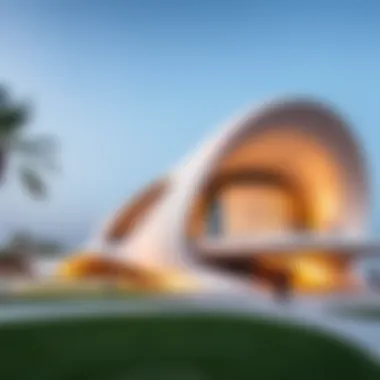
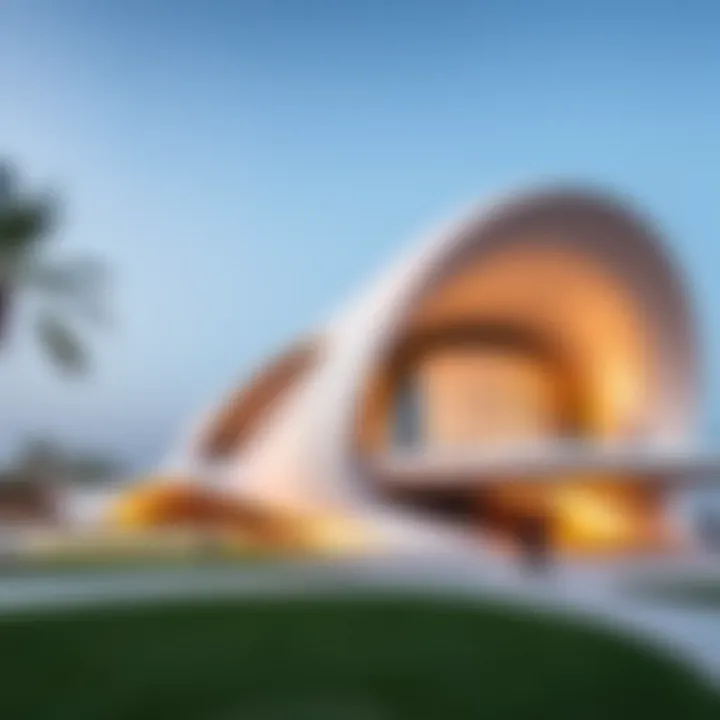
The Future of UAE Architecture
The evolution of architecture in the United Arab Emirates signifies more than just bricks and mortar—it's a reflection of the nation's aspirations, values, and identity. As the UAE stands at the crossroads of tradition and modernity, its future architectural endeavors hold immense importance. This section delves into the trends shaping the landscape of urban development and explores how technology will continue to influence architectural practices in the region.
Trends to Watch
In the ever-changing realm of architecture, several key trends are inching to the forefront, each cornering a piece of the architectural pie. Some of these trends include:
- Sustainable Design: Developers are increasingly prioritizing green building concepts that minimize environmental impact. This includes the use of renewable materials, energy-efficient systems, and designs that harmonize with the natural landscape.
- Mixed-Use Developments: Combining living, working, and leisure spaces within a single development is becoming ever more popular. There's a growing realization that people want convenience and community in their daily lives.
- Smart Buildings: With the infusion of smart technology, buildings are evolving into intelligent structures. Features like automated lighting, climate control, and security systems not only enhance comfort but also drive operational efficiency.
- Cultural Integration: New projects seek to reflect the rich history and diverse culture of the UAE, weaving local influences into modern designs without compromising on contemporary aesthetics.
- Vertical Landscapes: As land becomes scarce in urban areas, architects are looking up. This includes vertical gardens or farms that add greenery to urban settings, creating a healthier environment.
The melding of these trends creates a vibrant tapestry of architectural innovation in the UAE, making it crucial for investors and homebuyers to stay abreast of these developments.
The Influence of Technology
The infusion of technology into architecture is no longer a futuristic dream but a present-day reality. New-age tools and methodologies are transforming the architectural landscape dramatically. Here are a few ways technology is rescripting the playbook:
- Building Information Modeling (BIM): This advanced technology allows architects to create detailed 3D models. BIM streamlines the planning phase and provides insights into potential design issues before they become costly errors on-site.
- 3D Printing: 3D printing is not just for prototypes anymore; entire buildings are now being constructed using this method. It reduces waste and can significantly speed up the building process, all while cutting down costs.
- Augmented and Virtual Reality: These technologies are setting a new standard for client presentations by allowing stakeholders to immerse themselves in project designs before they are even built. It's a game-changer for ensuring client satisfaction and refining concepts.
- Drones and Robotics: From surveying land to inspecting hard-to-reach locations, drones are becoming an indispensable tool in architecture. Robotics can also assist in construction tasks, improving efficiency and safety.
The integration of technology not only enhances the design process but also shapes the future of construction methods, giving rise to new efficiencies and creative possibilities.
"The architectural landscape of the UAE isn't just about structures; it embodies a vision that reflects both tradition and innovation."
In summary, the future of UAE architecture promises a dynamic interplay between sustainability, technological advancement, and cultural integration. As this trend unfolds, it offers a fresh perspective for investors and stakeholders looking to participate in the region's architectural renaissance.
Architectural Awards and Recognition
In the realm of architecture, awards hold immense relevance as they not only celebrate outstanding design but also spotlight innovation and cultural significance. For the UAE, a region that prides itself on its rapid development and architectural prowess, these recognitions are pivotal. They serve as a benchmark for both local and international architects, guiding them towards excellence and creativity.
Achievements in architectural awards elevate the profiles of the winners, proving indispensable for firms and professionals. When a building garners accolades, it can influence real estate desirability, increase property values, and enhance the overall reputation of a locale. It’s a cycle of recognition and prestige, pushing architects to break barriers and think outside the proverbial box.
Moreover, awards often help in defining the narrative of a country’s architectural identity. As the UAE continues to evolve, these honors express how its structures meet modern needs while respecting local traditions.
In summary, awards in architecture are more than mere trophies; they're a reflection of a nation’s aspirations and achievements.
Prominent Awards
The UAE is host to several distinguished architecture awards that recognize innovative designs and sustainable practices. Some of the most notable ones include:
- The Dubai Design Week Awards: Celebrating creativity and design across multiple disciplines, this award focuses on projects that have a lasting impact on the community.
- The Arab Architects Awards: This prestigious award acknowledges outstanding architectural projects in the Arab world, with a category specifically for UAE projects.
- The Middle East Architecture Awards: Highlighting the best in Middle Eastern design, it showcases some of the region's most iconic buildings and their developers.
- The International Property Awards: This award includes categories for the UAE, acknowledging the best residential and commercial properties in the region.
These awards not only commend exceptional work but also encourage architects to pursue sustainable and forward-thinking projects.
Impact on International Standing
The influence of architectural awards extends beyond the local scene, positively impacting the UAE's international standing. Winning global accolades positions the UAE as a leader in architectural innovation, attracting investors and tourists alike. Buildings recognized on the world stage enhance the UAE’s image as a vibrant hub for design and creativity.
For instance, when the Burj Khalifa received the prestigious "Skyscraper of the Year" award, it didn't just affirm the building's architectural brilliance; it also cemented Dubai's status globally. Such recognition leads to a ripple effect, where tourists swarm to experience award-winning creations firsthand, thus boosting the economy.
Additionally, being the recipient of international awards can open doors for collaborations with renowned architects and firms from various countries. This networking fosters the exchange of ideas, continuously enriching the local architectural landscape. In the end, awards are critical in shaping perceptions, influencing investment decisions, and revitalizing urban spaces in the UAE.
"Awards are not just celebrations; they are a reminder of what can be achieved through vision, hard work, and a commitment to innovation."
Government Initiatives Supporting Architecture
Government initiatives play a pivotal role in shaping the architectural landscape of the United Arab Emirates. By implementing policies and programs that encourage innovative designs and sustainable building practices, the government sets a stage for future development while respecting cultural heritage. This enthusiasm for architecture is evident as many governmental bodies actively promote and invest in landmark projects that define the country’s skyline and narrative.
One of the most critical elements of these initiatives is the Vision 2021 plan. Launched by the UAE government, this vision aims to elevate the quality of life for residents while transforming the UAE into a global hub for trade, tourism, and investment. Within this framework, architecture is not just about erecting buildings; it encapsulates the larger purpose of enhancing civic life, environmental sustainability, and maintaining cultural identity. Government-funded projects that highlight green architecture, such as Masdar City in Abu Dhabi, serve as exemplars of eco-friendly innovations integrated with traditional architectural aesthetics.
Moreover, financial incentives and grants from the government make it easier for architectural firms and developers to adopt sustainable practices. Here are some ways the government supports architecture:
- Funding for Innovative Designs: The government provides grants or tax relief for projects that demonstrate cutting-edge designs or sustainable building methods.
- Regulatory Framework: Establishing clear guidelines that encourage eco-friendly architecture while simplifying the approval process for new structures.
- Collaborative Projects: Partnering with universities and research institutions to inspire new generations of architects and engineers through mentorship programs and competitions.
- Cultural Preservation: Supporting projects that balance modernity with the preservation of historical buildings, ensuring the UAE’s rich history is not overshadowed by rapid development.
"Architecture is a reflection of societal values; in the UAE, this is apparent as we see a keen blend of innovation and tradition."
The initiatives also extend to public awareness campaigns that promote the importance of architecture not only as functional structures but as works of art that define a city’s character. Workshops, exhibitions, and community engagements encourage citizen participation in architectural conversations, making it an inclusive process that fosters a sense of belonging.
As a result, these government initiatives not only enhance the physical landscape of the UAE but also contribute to a broader cultural dialogue that underpins its identity. The architecture is a testament to the vision of a nation that embraces both change and tradition, as well as a beacon for investors, agents, homebuyers, and managers looking to understand its potential future.
In summary, government initiatives supporting architecture serve multiple purposes: they foster innovation, encourage sustainability, and uphold cultural values. This focused approach propels the UAE towards a distinctive architectural future that remains rooted in its rich heritage and poised for global recognition. For more on architectural developments, one can refer to resources such as Wikipedia or Britannica.
The End: The Significance of Architectural Identity
In the grand tapestry of the United Arab Emirates, architecture serves not merely as a shelter but as a vivid expression of cultural identity and evolution. Each landmark discussed in this article embodies a facet of the nation’s unique narrative, blending tradition with modernity in striking and thought-provoking ways.
The architectural landscapes of the UAE reflect the historical journey of its people, showcasing their openness to innovation while staying true to their rich heritage. Take the Sheikh Zayed Grand Mosque, for instance. It represents a bridge between the past and the present, drawing on Islamic artistry while incorporating contemporary design principles. This blend reinforces how cultural reverence and progressive vision can coalesce beautifully, shaping national identity.
A key benefit of recognizing the significance of architectural identity is its potential to attract investment and economic growth. Investors and homebuyers looking toward the UAE are often captivated not just by the financial opportunities but also by the unique lifestyle fostered by these impressive structures. They offer not just a place to reside or work, but a connection to a deeper cultural context that enriches the living experience.
Additionally, these architectural marvels play a crucial role in enhancing the UAE's standing on a global stage. Structures like the Burj Khalifa and the Louvre Abu Dhabi act as beacons, drawing international attention and visitors from all corners of the world. Such tourism boosts local economies and further emphasizes the importance of innovative architecture in promoting cultural exchange and dialogue.
However, it is essential to consider that the evolution of architectural identity must respect environmental stewardship and sustainability. As regions like Masdar City showcase, future developments can pave the way for eco-friendly designs that preserve natural beauty while embracing urban growth. Citizens and policymakers need to strive for a balance between preserving cultural integrity and advancing sustainability.
"A building is not just a collection of materials; it is the encapsulation of cultural, social, and environmental narratives that define us."
Ultimately, the architectural landmarks of the UAE serve as more than mere tourist attractions or investments; they are essential to the essence of what it means to be a part of this vibrant nation. Acknowledging this significance helps strengthen the bond between architecture and identity, ensuring that these structures continue to tell the story of the UAE for generations to come.





